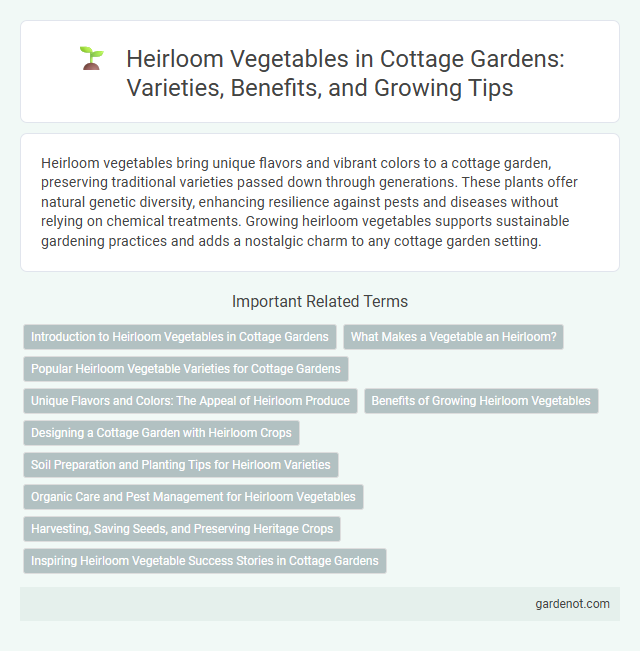Heirloom vegetables bring unique flavors and vibrant colors to a cottage garden, preserving traditional varieties passed down through generations. These plants offer natural genetic diversity, enhancing resilience against pests and diseases without relying on chemical treatments. Growing heirloom vegetables supports sustainable gardening practices and adds a nostalgic charm to any cottage garden setting.
Introduction to Heirloom Vegetables in Cottage Gardens
Heirloom vegetables in cottage gardens are prized for their rich genetic diversity and unique flavors, often passed down through generations. These open-pollinated varieties thrive in traditional garden settings, contributing to sustainable gardening practices by preserving rare seeds. Incorporating heirloom vegetables enhances the aesthetic and ecological value of cottage gardens while supporting heritage agriculture.
What Makes a Vegetable an Heirloom?
Heirloom vegetables are defined by their open-pollinated seeds, which have been preserved and passed down through generations for at least 50 years. These varieties are cultivated for their rich genetic diversity, exceptional flavor, and historical significance within cottage gardens. Unlike hybrid vegetables, heirlooms maintain stable traits year after year, allowing gardeners to save seeds and sustain unique plant lineages.
Popular Heirloom Vegetable Varieties for Cottage Gardens
Popular heirloom vegetable varieties for cottage gardens include Brandywine tomatoes, known for their rich, sweet flavor and large, beefsteak-style fruit. Purple Dragon carrots offer a unique appearance with their deep violet color and tender texture, making them a vibrant addition to any garden. Additionally, Glass Gem corn stands out for its multicolored kernels and adaptability, perfect for both ornamental and edible uses in cottage gardens.
Unique Flavors and Colors: The Appeal of Heirloom Produce
Heirloom vegetables in a cottage garden offer unique flavors and vibrant colors that modern hybrids often lack, enriching culinary experiences with their rich and diverse taste profiles. These varieties preserve genetic diversity by maintaining traditional traits passed down through generations, contributing to both sustainability and heritage. Cultivating heirloom produce enhances the visual appeal of garden beds with their distinctive hues while supporting organic and non-GMO growing practices.
Benefits of Growing Heirloom Vegetables
Growing heirloom vegetables in a cottage garden preserves genetic diversity, offering rich flavors and superior nutritional value compared to commercial hybrids. These vegetables are well-adapted to local climates, reducing the need for chemical inputs and promoting sustainable gardening practices. Cultivating heirloom varieties also supports biodiversity and connects gardeners to agricultural heritage, enhancing both ecological health and cultural appreciation.
Designing a Cottage Garden with Heirloom Crops
Incorporating heirloom vegetables into a cottage garden enhances biodiversity and preserves genetic variety while providing unique flavors and textures. Designing with heirloom crops involves selecting varieties adapted to the local climate and integrating them with traditional cottage plants like flowers and herbs for both aesthetic appeal and functional yield. Rich soil preparation and companion planting techniques optimize growth, ensuring a thriving, sustainable garden that reflects historical cultivation practices.
Soil Preparation and Planting Tips for Heirloom Varieties
Heirloom vegetable success in a cottage garden depends heavily on well-prepared soil rich in organic matter and balanced nutrients, ensuring optimal root development and nutrient uptake. Loosen the soil to a depth of at least 12 inches and incorporate compost or aged manure to improve texture and fertility. Plant heirloom seeds at recommended depths and spacing to promote healthy growth, and consider using seed starting trays with a sterile medium for delicate varieties before transplanting outdoors.
Organic Care and Pest Management for Heirloom Vegetables
Heirloom vegetables in a cottage garden thrive best through organic care practices such as compost enrichment and mulching, which enhance soil fertility naturally. Effective pest management involves companion planting with aromatic herbs like basil and marigold to deter harmful insects without synthetic chemicals. Regular monitoring and manual removal of pests preserve plant health while maintaining the garden's ecological balance.
Harvesting, Saving Seeds, and Preserving Heritage Crops
Harvesting heirloom vegetables at peak ripeness ensures maximum flavor and nutrient retention, supporting the preservation of unique genetic traits. Saving seeds from these crops maintains biodiversity and allows gardeners to cultivate plants adapted to local conditions year after year. Preserving heritage varieties contributes to safeguarding agricultural history and promotes sustainable gardening practices in cottage gardens.
Inspiring Heirloom Vegetable Success Stories in Cottage Gardens
Heirloom vegetables thrive in cottage gardens, showcasing vibrant colors and rich flavors that modern hybrids often lack. Gardeners sharing inspiring success stories highlight how varieties like Brandywine tomatoes and Blue Lake beans consistently produce abundant, disease-resistant crops. These tales emphasize the importance of preserving genetic diversity and fostering sustainable, organic growth within charming, rustic garden spaces.
Heirloom vegetable Infographic

 gardenot.com
gardenot.com